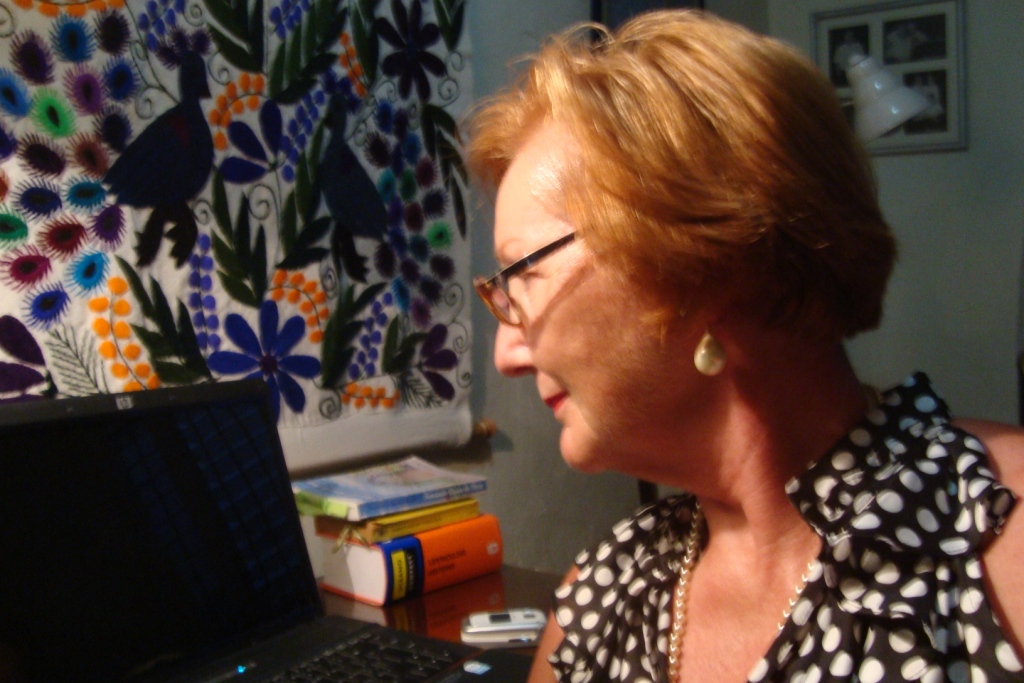 I have been asked to compile a list of Latina writers.
I have been asked to compile a list of Latina writers.
When one thinks of “Latina writers”, immediately names like Sandra Cisneros, Laura Esquivel and Isabel Allende come to mind. Women with Latin roots who write about issues related to their ethnicity.
Several well known Latina writers do not have Latin surnames: Elena Poniatowska, Denise Dresser, Veronica Chambers. But no one would ever describe them as anything other than Latinas.
Elena Poniatowska
A third group are authors like Harriet Doer. Leonore Carrington and C.M. Mayo. These women, while not born in a Latin country write powerfully and seductively about Latin cultures.
So what is the definition of LATINA? Merriam Webster’s on line version offers this:
“1: a woman or girl who is a native or inhabitant of Latin America
2: a woman or girl of Latin-American origin living in the United States”
Hm-m-m-m-m… no precise mention of foreign born, naturalized citizens of Latin countries or women of Latin-  American origin who live in other countries…
American origin who live in other countries…
Maybe calling oneself Latina describes more than ethnicity? Perhaps it is a matter of sentiment and life experience?
Leonore Carrington



Dictionaries, I’m learning, are quite variable. And given our rapidly contracting world, the changes in vocabulary are accelerating. I’d been researching the word “Latino” myself, and was surprised to see that so many sources link it to the USA vocabulary. But then I found, in Dictionary.com, that the origin of the word dates to 1945-50, and is termed an “Americanism.” They defined is as “a person of Latin-American or Spanish-speaking descent,” a more encompassing definition that the Webster’s. THEN, very recently, I see the word used in a Diario de Yucatan headline which described a Lebanese event.
A bit off the subject–I’ve also read that some dictionaries even make up words, in order to trap plagiarists!
I like the part about dictionaries having made up words… that’s interesting. I wonder how you know which are the invented words? Maybe they have a little symbol beside them?
Great comment and post, I will look for some of those writers. I love Denise Dresser, I’ve read a few of her articles with my Spanish class. Elena Poniatowska is an icon and while I don’t agree with much of her politics, not a deal breaker for me, I love her style and her presence.
THanks Jonna, I think you’ll enjoy the recommendations. Also those in the comment posted by C.M. Mayo
Hola Joanna, This is such an interesting and vital point! Another to mention is Alma Reed, who was born in California, became an important journalist in San Francisco, and then for the New York Times, and while reporting on archeological digs, was swept up (I can’t think of a better word) into becoming the fiancee of Felipe Carrilo Puerto, the charismatic and progressive governor of the state of Yucatan who ended up assassinated. In an incredible series of coincidences, Michael Schuessler found Alma’s autobiography and letters from Carrillo Puerto only a few years ago in an abandoned apartment in Mexico City. In the book published by University of Texas Press, PEREGRINA: LIFE & DEATH IN MEXICO by Alma Reed, edited by Michael Schuessler, there is in a wonderful introduction in which Elena Poniatowska writes,
“Reed was part of a group of bold North American women who arrived in Mexico seeking to learn about the revolution and there devoted themselves to the study and promotion of Mexican culture. Among them are Frances Toor; Alice-Leone Moats; Anita Brenner, who was born in Aguascalientes, lived in the United States, and exposed her splendid backside to Edward Weston; Emily Edwards, who commissioned Manuel Alvarez Bravo to take photographs of Mexican murals; Tina Modotti; Grace and Marion Greenwood, who painted murals in the Abelardo Rodriguez Market alongside Fermin Revueltas and Pablo O’Higgins. ..”
My favorite writer of the “NonLatina Latinas,” as I suppose we might call them, is Fanny Calderon de la Barca, the Scottish-born wife of Spain’s first (post-Independence) ambassador to Mexico. She wrote a book (or rather a collection of letters) that is, in the best and most sparkling sense of the word, a classic: LIFE IN MEXICO. Joanna, I am sure you know it— to your readers who don’t: Go read it, ahora mismo!
A final thought on this subject. We get caught up in categories because they’re easy and because, very often they serve a political purpose. But reality is complex and oftentimes muddy. This is one the points of my books, MIRACULOUS AIR (about Baja California, where so many people have come from elsewhere, including, ay, Japan and Italy) and THE LAST PRINCE OF THE MEXICAN EMPIRE, based on he true story of Maximilian’s heir presumptive, Agustin de Iturbide y Green (b. 1863 d. 1925), who was the grandson of Mexico’s “Liberator,” Agustin de Iturbide. Why the name Green? Mexico’s last prince’s mother was from that very prominent Washington DC family, and because her grandfather, General uriah Forrest, had served with Washington during the Revolution, many members of that family are in the Daughters of the American Revolution and the Society of the Cincinnatti— including Agustin de Iturbide y Green. I went to the library there and found his file.
What a wonderful comment. Thank you so much for taking the time to include this information for the readers. I would second your recommendation of the book by Madame Calderon de la Barca. It is an absolutely fascinating account. All the others…also excellent reads. Although you have given the names of women who came to Mexico, other female trail blazers arrived on the shores of other Latin American countries. One of my favorite books of all time is by Flor Tristan (Gaugin’s grandmother) “Perigrinations of a Paraiah” takes readers from France to Peru in the 1860s! What a story… ¡Enhorabuena!